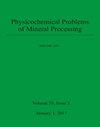Effect of ultrasonic pretreatment on flotation purification of quartz
IF 1.2
4区 工程技术
Q2 Earth and Planetary Sciences
引用次数: 0
Abstract
Quartz sand purity dictates its applications, with current research focusing on flotation purification. To investigate the effects of ultrasonic pretreatment on quartz flotation, an RKIII single-tank flotation machine was employed at a neutral pH of 6.8, and the impacts of varying ultrasonic powers (120-300 W) and different treatment durations (0-25 min) were discussed. Additionally, ultrasonic pretreatments were carried out in acidic and alkaline environments simulated by 1%-5% solutions of hydrochloric acid and sodium hydroxide, respectively. Through the analysis of impurity content in quartz sand, it was found that under natural pH conditions and a power range of 120-300 W, the optimal purification effect was achieved by adding 100 g of quartz sand to 1200 cm3 of deionized water and subjecting it to ultrasonic treatment for 10-15 min. As the ultrasonic power increased, the purification effect was enhanced. The results showed that the removal of Fe2O3, TiO2, and Al2O3 was increased by 10.4%, 3.3%, and 1.2%, respectively, compared with that of the conventional flotation after ultrasonic pretreatment for 15 min with ultrasound power 240 W in a neutral environment. In the optimal 5% HCl solution, the removal rate of Fe2O3 was 11.2% and 21.6% higher than that of the control group and the untreated group, respectively. The removal rate of TiO2 was 4.6% and 7.9% higher, respectively. The removal rate of Fe2O3 increased by 23.2% and that of TiO2 increased by 9.1% with 240 W ultrasonic treatment in 4% NaOH solution.超声波预处理对浮选提纯石英的影响
石英砂的纯度决定了其用途,目前的研究重点是浮选提纯。为了研究超声波预处理对石英浮选的影响,在中性 pH 值为 6.8 的条件下使用了 RKIII 单槽浮选机,并讨论了不同超声波功率(120-300 W)和不同处理持续时间(0-25 分钟)的影响。此外,还在酸性和碱性环境中分别用 1%-5%的盐酸和氢氧化钠溶液模拟进行了超声波预处理。通过对石英砂中杂质含量的分析发现,在自然 pH 值条件和 120-300 W 功率范围内,将 100 克石英砂加入 1200 立方厘米的去离子水中并进行 10-15 分钟的超声波处理,可达到最佳净化效果。随着超声波功率的增加,净化效果也随之增强。结果表明,在中性环境下,超声波功率为 240 W,超声波预处理 15 分钟后,Fe2O3、TiO2 和 Al2O3 的去除率分别比传统浮选提高了 10.4%、3.3% 和 1.2%。在最佳 5% HCl 溶液中,Fe2O3 的去除率分别比对照组和未处理组高 11.2% 和 21.6%。对 TiO2 的去除率分别提高了 4.6% 和 7.9%。在 4% NaOH 溶液中用 240 W 超声波处理,Fe2O3 的去除率提高了 23.2%,TiO2 的去除率提高了 9.1%。
本文章由计算机程序翻译,如有差异,请以英文原文为准。
求助全文
约1分钟内获得全文
求助全文
来源期刊

Physicochemical Problems of Mineral Processing
工程技术-矿业与矿物加工
CiteScore
2.20
自引率
6.70%
发文量
99
审稿时长
3.3 months
期刊介绍:
Physicochemical Problems of Mineral Processing is an international, open access journal which covers theoretical approaches and their practical applications in all aspects of mineral processing and extractive metallurgy.
Criteria for publication in the Physicochemical Problems of Mineral Processing journal are novelty, quality and current interest. Manuscripts which only make routine use of minor extensions to well established methodologies are not appropriate for the journal.
Topics of interest
Analytical techniques and applied mineralogy
Computer applications
Comminution, classification and sorting
Froth flotation
Solid-liquid separation
Gravity concentration
Magnetic and electric separation
Hydro and biohydrometallurgy
Extractive metallurgy
Recycling and mineral wastes
Environmental aspects of mineral processing
and other mineral processing related subjects.
 求助内容:
求助内容: 应助结果提醒方式:
应助结果提醒方式:


